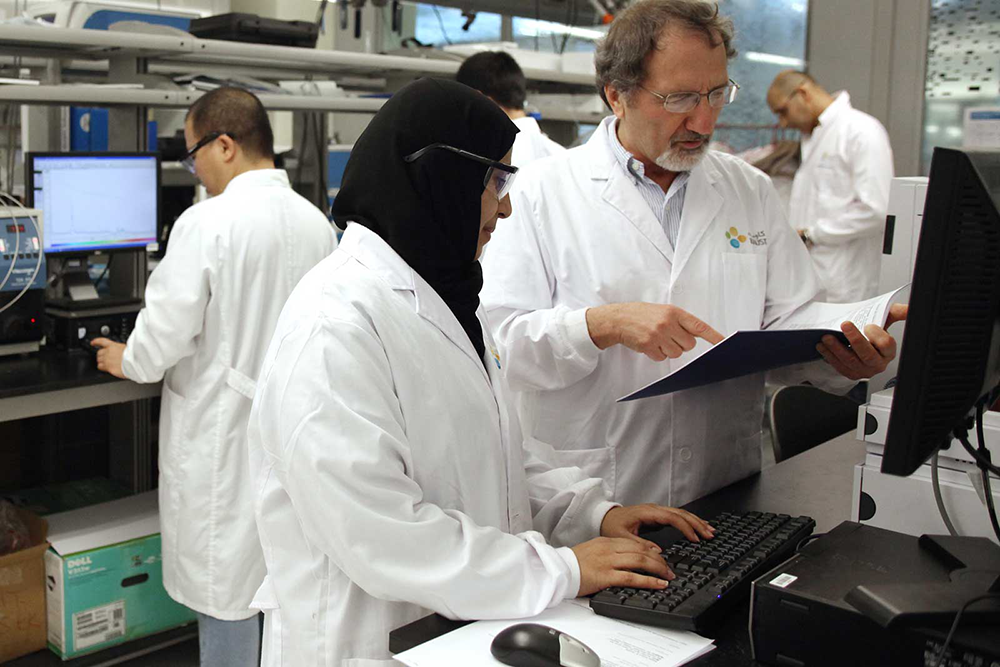Faculty Focus: POLY Fellow recipient Prof. Nikos Hadjichristidis talks about the future of polymer science
KAUST’s Prof. Nikos Hadjichristidis was recently selected as a 2014 POLY Fellow for his contributions in advancing the field of polymer science. Established in 2009, this prestigious award recognizes excellence in advancing the field of polymer
science, either through scientific accomplishments, service to the profession, or both. The Polymer Chemistry Division of the American Chemical Society gives out the award.
With more than 450 papers published in scientific journals and 19 patents,
Prof. Hadjichristidis’s research is impressive. Currently a Professor of Chemical Science in KAUST's Catalysis Center, we wanted to know more about his research goals and his where he sees polymer science going in the future.

What brought you to KAUST and when did you join?
I joined KAUST in September 2011 and I came with a dream: to build a worldwide Polymer Synthesis Laboratory, and thus to contribute to the vision and mission of KAUST. I did the same in Greece after coming back from USA and Canada to the University of Athens.
While in Greece, I was the first to introduce Polymer Science Courses and Research and establish the Polymer Greek Society. I was also a founding member of the European Polymer Federation. Consequently, I have the experience to build the laboratory here and KAUST gives us all possible means to do that.
Another part of my dream was to educate our students and in particular the Saudi students. This is the reason why I have seven Saudi students on my team.
How does it feel to be honored for advancing the field of polymer science?
It is the first time I got an international award (American Chemical Society) under KAUST affiliation and I am very proud of that. This award is giving me
the strength to continue research and teaching in polymer science at KAUST to realize my dream.
What is the main focus of your research?
My main research focus is the synthesis of model polymers with different macromolecular architectures. Access to these model polymers (high degree of structural, compositional and molecular
weight homogeneity) is necessary in order to elucidate the structure-property relationships, which are key in improving the polymer performance and designing new materials.
The synthesis of model polymers is demanding, time consuming and often
leads to a small quantity of products. Nevertheless, this is a small price to pay given the tremendous potential of the model macromolecules for selecting the appropriate structures needed for specific applications. In addition, these polymers can
help scientists carrying out research on other disciplines including membranes, solar and fuel cells, biomaterials, etc.

How did you get interested in polymeric materials?
Polymers are everywhere in our everyday life. Just like we had the Stone Age, the Bronze Age and the Iron Age, we can call our age the Plastics Age.
In addition to this, the reasons I chose polymer science is because first of all, God created nature and nature, the perfect chemist, uses polymers, such as protein, DNA, cellulose and other components to do its job. And secondly, the multi-discipline character of polymer science, which makes it very exciting and attractive, also impressed me.
What advantages or unique properties do polymeric materials have over others?
Polymeric materials are stronger, lighter, non-fragile and cheaper than the conventional materials like metal, wood and glass. But the most amazing characteristic is that from one precursor (called monomer) we can prepare a thousand different polymeric materials with properties that can be tailored.
Is there a specific project you are working on that has you excited?
In collaboration with Dean Professor Yves Gnanou, who is a great polymer scientist, we are working on different projects including:
But one of my most exiting projects at the moment is the development of a new methodology that combines anionic polymerization with polyhomologation, a novel polymerization method, through a “bridge” molecule (BF3OEt2). This is used to synthesize a new family of polymeric materials with very interesting properties.
One other really interesting project is the discovery of a novel efficient initiator for the preparation of well-defined Polypeptides and Biopolymer/Polypeptide hybrids.
How is your research used to help solve today's problems?
Let me give you three examples: The Low Density Polyethylene (LDPE), one of the most popular industrial polymers that are found in plastic bags, films and other common items, has a good processability, but weak mechanical properties. On the other hand, High Density Polyethylene (HDPE) is strong, but possesses poor processability. Our research helped to make stronger LDPE without losing its good processability.
Another example is the design and preparation of nano objects with different shapes and sizes. These nano objects are very important for high temperature membranes and nanolithography, which are found in integrated circuits, digital data, nanoreactors, sensors, etc.
A third example is the design of better drug delivery systems from copolypeptides.
While at KAUST, Prof. Hadjichristidis’s did realize his dream of building a worldwide polymer synthesis laboratory in Saudi Arabia. To see some of the research being done in the lab, visit his Polymer Synthesis Laboratory website.